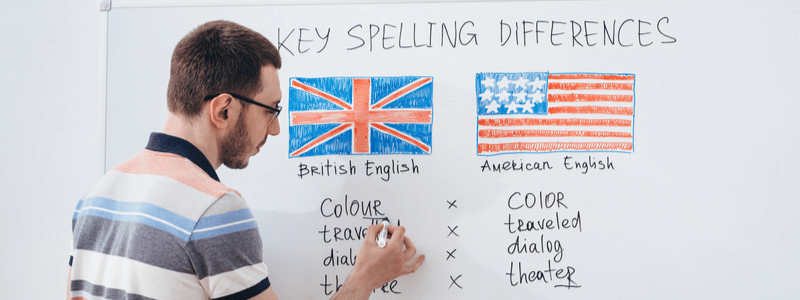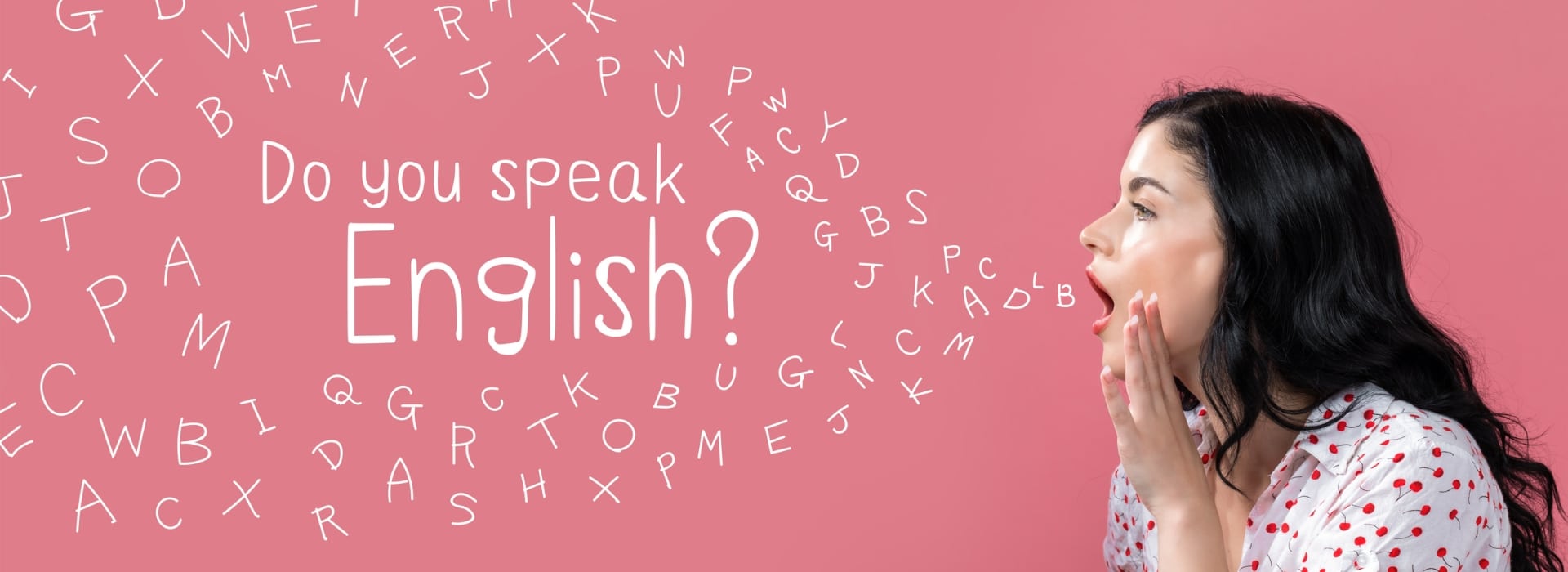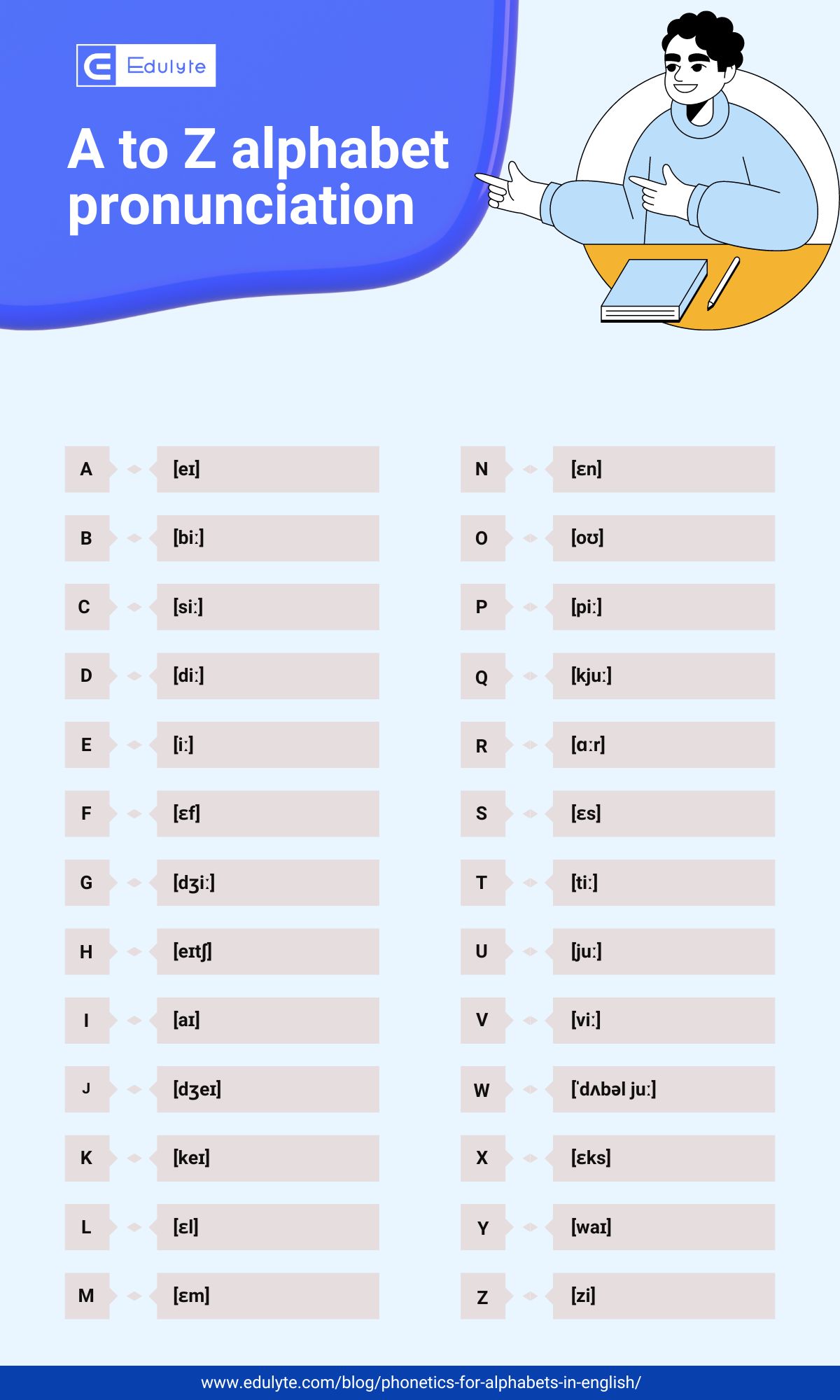Estimated reading time: 11 minutes

Get the basics of English phonetics for the alphabet and pronunciation clear. Pick up tricks to recognise the correct pronunciation of words and learn to read the phonetics alphabet chart.
Navigating English Alphabets through Phonetics?
Phonetics, or the study of speech sounds, deals with pronouncing letters and words. Confused? In easy terms, phonetics is how we speak and hear the sounds of the language. Phonetics sounds start with a letter in the alphabet, and we combine these sounds to say the words correctly. However, the phonetics of the alphabet in English can be challenging even for native English speakers. Also, the phonetic alphabet of UK English can differ from its American counterpart. Thus it becomes crucial to know the precise sounds if your first language isn’t English.
Phonetic Alphabet in English
Phonetics isn’t to be confused with letters. They are but the sound of the letters. Phonetics for alphabets indicates how the sound of the letter is to be made. It is necessary to use a unique alphabet to depict the pronunciation of words, as the regular English alphabet lacks all the letters to show the language sounds.
Phonetic alphabet letters/list
The International Phonetic Alphabet (IPA) denotes each symbol to a particular English sound. It helps you to pronounce a word correctly. It improves your English pronunciation and makes you confident speaking in English, whether you are learning English on your own or with a specialist.
The vowels in English are a, e, i, o and u. The vowel sounds are made with keeping the mouth fairly open, so there isn’t much hindrance for the air to move out of your mouth.
The English alphabet has 26 letters. These represent 44 sounds. Each letter of the alphabet stands for more than one sound. Also, the same sound is represented by different letters of the alphabet.
You can refer to this video to understand how to make vowel sounds: Pronunciation of vowels.
The consonant sounds are made with the mouth relatively closed. There is an obstruction to the air movement from your mouth depending on how closed the mouth is and the location of the tongue while making a particular sound.
You may refer to this video for the consonant sounds: Pronunciation of consonants.
Go through the following tables of 12 vowel sounds, 8 diphthongs (when two vowels come together to make a sound), and 24 consonant sounds with their respective words.

Short Vowel
| Symbol | Sound |
|---|---|
| /ɪ/ | fit, kit |
| /e/ | pet, get |
| /æ/ | sat, mad |
| /ʌ/ | cut, cover |
| /ʊ/ | put, hook |
| /ɒ/ | pot, hospital |
| /ə/ | about, complete |
Long Vowels
| Symbol | Sound |
| /i:/ | week, media |
| /ɑ:/ | lark, park |
| /ɔ:/ | fork, talk |
| /ɜ:/ | curd, word |
| /u:/ | prove, food |
Dipthongs
When two vowels get together to produce a sound, they are called dipthongs, like /aɪ/ as in sky, buy, ʊə/ as in tour, poor
| Symbol | Words |
| /eɪ/ | able, age |
| /oʊ/ | over, older |
| /aʊ/ | mouth, house |
| /ɪə/ | real, period |
| /eə/ | hair, care |
| /ɔɪ/ | boy, toy |
| /aɪ/ | life, behind |
| /ʊə/ | poor, during |
Consonants
The voiced and unvoiced consonants are given below.
| Symbol | Sounds |
| /p/ | pet, powerful |
| /b/ | but, between |
| /t/ | better, time |
| /d/ | dime, daughter |
| /k/ | crazy, quite |
| /g/ | glass, grow |
| /f/ | phone, fan |
| /v/ | have, village |
| /s/ | centre, sail |
| /z/ | design, cozy |
| /ʃ/ | fish, show |
| /ʒ/ | pleasure, measure |
| /ʧ/ | touch, chuck |
| /ʤ/ | giant, job |
| /θ/ | throne, moth |
| /ð / | there, brother |
| /l/ | luck, sell |
| /m/ | monkey, mail |
| /n/ | name, never |
| /ŋ/ | finger, singer |
| /h/ | hear, hole |
| /r/ | rare, compare |
| /j/ | use, you |
| /w/ | week, one |
Expert Tips for Unlocking the Power of Phonetic Alphabets in English
English isn’t a phonetic language. Yes, you read that right!
English can be confusing to read as the different sound combinations can perplex you! For example, tough can be said as “tuff”, yet dough is pronounced as “dou”.
So how does one learn the phonetics alphabet when the sounds can be intimidating?
Be creative with Mnemonic
Through images, patterns, acronyms and rhymes, you can create your Mnemonic that can help you remember the sounds of the phonetic alphabet.
/i;/ – meat – /miːt/

pot /pɒt/


Test yourself on the go
See the letters on the billboards? Or the name of the shop? Start testing yourself for the sounds of the letters that you see. It is fun and assists in learning in a stress-free manner. Run through the letters of the names of your family members, friends, and colleagues. Figure out their sounds and write them down. Check and see if you can get the correct phonetics letters.

Listen and Record yourself.
Watching movies and documentaries in English is a great way to pick up the pronunciation of phonetics for the alphabet. Another interesting and informative way is listening to podcasts: 6 Minutes English, Voice of America: Learning English After listening to a programme segment, record yourself, note the sounds you have a problem with, and practice them slowly.

Benefit from English classes
Online tutoring platforms like Edulyte offer personalised classes that can empower you to improve your English speaking skills and improve your grasp of the language. Click here to learn more about how we can enable your learning. These are foolproof ways to get the hang of phonetics and improve your English pronunciation
Who needs English tutor?
List of phonetic alphabet NATO
The NATO phonetic alphabet was created in 1956 through the North Atlantic Treaty Organization (NATO) and the International Civil Aviation Organization (ICAO) joint effort. The phonetic alphabet was developed for the military and has become popular in communication ever since.
It is helpful to prevent spelling mistakes or miscommunication, primarily when people from different countries, accents and pronunciations work together.
Each letter is assigned a particular word, so its name begins with the letter itself.
Accordingly, the NATO phonetic alphabet consists of 26 codewords, each representing a different letter of the English alphabet. These words are:
Alfa, Bravo, Charlie, Delta, Echo, Foxtrot, Golf, Hotel, India, Juliett, Kilo, Lima, Mike, November, Oscar, Papa, Quebec, Romeo, Sierra, Tango, Uniform, Victor, Whiskey, X-ray, Yankee, Zulu.
So if you have to spell the word: Negotiate, you will spell it as:
November Echo Golf Oscar Tango India Alfa Tango Echo
Exercises with phonetics in English
Here is a quick exercise for you to determine how well you know your phonetics for alphabets in English. Attempt the exercise and check the answers given below. You can always go back to the phonetics alphabet chart before you attempt the exercise.
- kaʊ → _____
- ˈkeəfʊl → _____
- breɪv → _____
- ʃɜːt → _____
- kæp → _____
- bluː → _____
- braʊn → _____
- ˈmʌðə → _____
- ruːf → _____
- faɪv → _____
- aɪ → _____
- heə → _____
- biːn → _____
- ˈkɪtʃɪn → _____
- naɪn → _____
- kaʊ → cow
- ˈkeəfʊl → careful
- breɪv → brave
- ʃɜːt → shirt
- kæp → cap
- bluː → blue
- braʊn → brown
- ˈmʌðə → mother
- ruːf → roof
- faɪv → five
- aɪ → eye
- heə → hair
- biːn → bean
- ˈkɪtʃɪn → kitchen
- naɪn → nine
A to Z alphabet pronunciation
Always remember that the letters of the alphabet do not represent the sound of the letters. Below are the sounds of the international phonetic alphabet, with the symbols for their correct pronunciations.
| Alphabet | Pronunciation |
| A | [eɪ] |
| B | [biː] |
| C | [siː] |
| D | [diː] |
| E | [iː] |
| F | [ɛf] |
| G | [dʒiː] |
| H | [eɪtʃ] |
| I | [aɪ] |
| J | [dʒeɪ] |
| K | [keɪ] |
| L | [ɛl] |
| M | [ɛm] |
| N | [ɛn] |
| O | [oʊ] |
| P | [piː] |
| Q | [kjuː] |
| R | [ɑr] |
| S | [ɛs] |
| T | [tiː] |
| U | [juː] |
| V | [viː] |
| W | [ˈdʌbəl juː] |
| X | [ɛks] |
| Y | [waɪ] |
| Z | [ziː] |
Conclusion
The knowledge of phonetics for alphabets in English is a must for every English language learner. It might seem challenging to scale, but with the tips given above and the proper guidance, the international phonetic alphabet can be easily handled. English is the communication language of the world. Proficiency in English assures better communication skills and the scope of availing exciting opportunities to study or work in English-speaking countries. So it is a sensible decision to familiarise yourself with English phonetics.
Similar Blogs
Learning lessons, study tips, career guides and much more!
A, An, The articles in English grammar : What are they and how to use them.
English language learners and even native speakers get confused over using a, an and the articles in English grammar. You would be surprised to know…
Learning English Grammar Online | Adjectives and their types
Adjectives are used to make comparisons between two persons or things. They even show a change in certain situations….
Frequently Asked Questions
The English language has 5 vowels which make different sounds depending on their use. check the sound here.
There are 44 sounds in English. Of course, some variations depending on the region where the language is spoken. The 22 letters of the English alphabet represent the 44 phonemes.
The sounds of the English alphabets are given in the table below. check the sound here.
An easy way to learn the English phonetic alphabet is:
* Check the Merriam-Webster dictionary online or Thesaurus for phonetics, letters of the words and pronunciation,
* Create mnemonics for phonetics
* Test your phonetic knowledge when you see a print advertisement or billboard.
* Join English classes such as the ones conducted by Edulyte’s English trainers to be proficient in the language.
You may be surprised to know that phonetically spelling your name can be quite easy. Break the parts of your name into syllables, capitalising the letter sounds one might emphasise when pronouncing your name.
If your name is Raul Gonzalez: rah-OOL gon-SAH-les
There being just 26 letters in the English language, there are approximately 44 unique sounds, also known as phonemes. The 44 sounds help distinguish one word or meaning from another.
How can you pronounce a word you’ve never read? How about a word in a foreign language? Sounds impossible? Now imagine a set of symbols that could help you pronounce any word in any language! And that is exactly what the International Phonetic Alphabet does. Currently, the IPA consists of 107 sound symbols, 52 diacritics (accents) and 4 prosodic marks (intonations) encompassing every phoneme used in nearly every language. It means that for any written word, you can identify the associated phoneme symbols and learn to pronounce the word with a bit of practice!
You think it’s time to pick up a new language?
The International Phonetic Association created the IPA. Founded in 1886 in Paris, their original mission was to help school children pronounce words in foreign languages and to aid in the teaching of reading. Today their mission is to promote the scientific study of phonetics.
English has 20 vowel sounds. Short vowels in the IPA are /ɪ/-fit, /e/-set, /æ/-mat, /ʌ/-cut, /ʊ/-put, /ɒ/-fog, /ə/-about. Long vowels in the IPA are /i:/-meek, /ɑ:/-card,/ɔ:/-fork,/ɜ:/-word, /u:/-moot.
Click here to know the sounds




